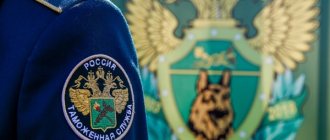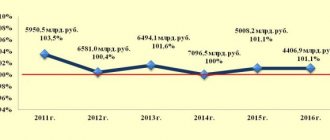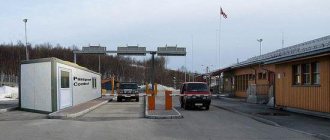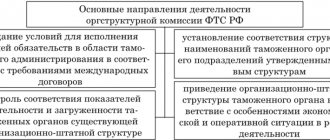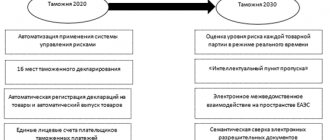Officials of the customs authorities of the Russian Federation
Article 3 of the Federal Law of July 21, 1997 N 114-FZ “On Service in the Customs Authorities of the Russian Federation” reveals the concept of “customs authorities officials”.
With the adoption of the Federal Law “On Service in Customs Authorities” (1997) and before the adoption of the Federal Law “On monetary allowances for employees of certain federal executive authorities, other payments to these employees and conditions for the transfer of certain categories of employees of the federal tax police and customs authorities of the Russian Federation” Federation for other conditions of service (work)” (2002), all officials were employees of customs authorities, who were assigned special ranks in accordance with the procedure established by law. According to Federal Law N 78-FZ, some employees transferred to positions in the federal state civil service, the content of the concept of a customs official has undergone changes (see commentary to the preamble).
Officials of the customs authorities of the Russian Federation currently include: 1) persons who have been assigned special ranks in the prescribed manner - customs officials; 2) persons who are assigned class ranks. The Law under comment does not directly name officials who are assigned ranks as federal civil servants, which creates some legislative uncertainty in their legal status.
Thus, at present, the concept of “customs officials” is a collective one, including two categories of employees serving in the customs authorities.
It should be noted that Federal Law No. 78-FZ did not establish the criteria by which positions should be divided into categories. As a result of the transition of some customs officers to the conditions of the state civil service, officials of the law enforcement unit of the customs bodies of the Russian Federation (units engaged in operational investigative activities, inquiries, administrative investigations, law enforcement units, aviation, maritime, and air units) remained as employees, as well as management composition of customs authorities up to and including heads of departments. At the same time, the customs authorities are gradually transferring the heads of the non-enforcement unit to positions in the federal state civil service. Thus, it can be assumed that in the future only law enforcement officers will remain customs officers. It seems that with the adoption of the federal law “On Law Enforcement Service,” the concept of “customs officer” should acquire a clear conceptual basis.
The assignment of an official to one category or another is of fundamental importance, since, in essence, it determines the type of service they perform in the customs authorities, as well as legal regulation. Differences in the legal regulation of the two categories of customs officials entail different procedures for serving in the customs authorities, as well as different legal status of officials, including the set of social guarantees and benefits provided.
Distinctive features of Russian customs
By legal nature, the customs service is equated to the military, but this is not entirely correct due to its regulatory and legal features. This is also emphasized in Decree of the President of the Russian Federation No. 2252 of December 22, 1993 “On the classification of customs authorities as state paramilitary organizations.” Therefore, it is correct to call it militarized, but not military service.
Customs officers have such signs of a militarized service, such as a system of special ranks, external attributes, stricter discipline, etc. However, the general nature of the activity is law enforcement (according to current legislation, customs is even included in the number of law enforcement agencies). This is also evidenced by the fact that employees, as subjects of executive power, carry out executive and administrative activities on behalf of the state.
Note. The distinctive features of the service in the customs authorities are emphasized by the attributes and symbols approved at the state level: coat of arms, flag, oath, uniform, special titles, professional holiday.
The essence of any activity is revealed through identifying its goals. And the main goal of service in the department is to ensure the economic sovereignty and economic security of the country, ensure the powers of border authorities and ensure the legal movement of goods and vehicles across the border of the Russian Federation. Based on the analysis of the goals of the activity, we can conclude that these state. authorities simultaneously act as fiscal and law enforcement, and these roles are organically interconnected.
Historical information
The customs policy of the 17th century was aimed at increasing fees, ensuring equal terms of trade on the all-Russian market and led to an increase in demands for collecting ruble duties in the same amount from everyone.
In the 1870s, laboratories of the Department of Non-Salary Fees of the Ministry of Finance began to be created, which carried out the examination of released and imported goods. In 1873, the Regulations on the Baltic Customs Cruiser Flotilla were approved.
The First World War (1914-1918) had a negative impact on the development of this area. The activities of most customs offices on the western border were suspended. After the events of the February Revolution, in September 1917, the first All-Russian Congress of Customs Officials of Russia was held, at which the Declaration and Charter were adopted and the Central Committee of the All-Russian Union of Customs Officials was created.
Reference. The period of the 19th – early 20th centuries in the history of Russian customs is characterized by the search for an optimal tariff regulation mechanism for the development of the Russian economy, which ultimately included both free trade and moderate protectionism.
The beginning of the activities of the Soviet customs service is based on the established pre-revolutionary system of customs institutions. The first Customs Charter of the USSR in 1924 established the structure of the border service. During the Great Patriotic War, the main functions, directions and forms of activity of customs authorities were determined by the customs policy of the USSR, which, on the one hand, was guided by the tasks of foreign trade in the context of the fight against Nazi Germany and its allies, and on the other hand, by the urgent need to develop domestic production in order to preserving and strengthening the state’s economy.
The three post-war decades were not marked by major changes in the organization of customs affairs. With the development in the second half of the 1950s - early 1960s, foreign trade, economic, cultural, tourist and other relations between the USSR and foreign countries, measures were taken to simplify border formalities when passing goods and citizens across the border.
The main results of the activities of the customs authorities in 1991-1996 were the creation of a multifunctional infrastructure adapted to the country’s market economy, and the formation of a legislative framework with the fundamental Customs Code and the Law “On the Customs Tariff of the Russian Federation”.
During the difficult period of the financial crisis and attempts to overcome the urgent need to replenish the state treasury in 1998-2004, there was a reform of the civil service, strengthening of the vertical system of customs authorities in the context of the ongoing state administrative reform, changes in customs legislation, strengthening of the information and technical component of the service, a breakthrough in electronic registration of goods flows, development of customs infrastructure, development of a support system for Russian entrepreneurs and participants in foreign trade activities.
Note. In 2004-2006, the customs service again underwent state administration, becoming the Federal Service under the Ministry of Economic Development of the Russian Federation. A new link in decision-making has emerged, which further bureaucratizes the activities of the Federal Customs Service of Russia.
A new stage in the development of the Russian customs service began on January 1, 2010, when the Customs Union of Russia, Belarus and Kazakhstan became operational. By this time, the Commodity Nomenclature of Foreign Economic Activity of the Customs Union, the Unified Customs Tariff, etc. had been developed. As part of the Second World Canine Forum in Moscow in May 2013, on the basis of the Central Customs (Canine Center of the Federal Customs Service of Russia), the official opening of the Regional Training Canine Center of the World War II took place. customs organization.
After the reunification of the Republic of Crimea and the Russian Federation, on March 18, 2014, in Simferopol, a meeting was held between the head of the Federal Customs Service of Russia A. Yu. Belyaninov and participants in foreign economic activity of Crimea. The meeting was attended by more than 50 representatives of the largest budget-generating enterprises of the Republic of Crimea. The head of the Federal Customs Service of Russia A. Yu. Belyaninov announced the creation of the Crimean and Sevastopol customs offices of direct subordination.
In 2021, the unified Commodity Nomenclature for Foreign Economic Activity of the Commonwealth of Independent States (CIS FEACN), the EAEU Commodity Nomenclature for Foreign Economic Activity and the Unified Customs Tariff of the Eurasian Economic Union were approved. The Commodity Nomenclature of Foreign Economic Activity of the CIS, the Commodity Nomenclature of Foreign Economic Activity of the EAEU and the Common Trading Code of the EAEU entered into force on January 1, 2021. During 2021, customs cooperation with the BRICS countries actively developed. In 2021, work began on the Comprehensive Development Program of the Federal Customs Service of Russia until 2021.
This is interesting:
What is customs regulation: functions, goals and legal basis of the concept
What does the concept of “Free Customs Zone” mean and what functions does it include?
Structure of the Federal Customs Service of the Russian Federation
The structure includes:
- Central office.
- Regional customs departments.
- Specialized customs departments.
- Customs offices directly subordinate to the Federal Customs Service of the Russian Federation.
- Representative offices abroad.
- Subordinate organizations.
The first apparatus includes the Main Directorates (organizational inspection department, organizations of customs clearance and control, federal customs revenues and tariff regulation, etc.) and Directorates (currency and export control, customs investigations and inquiries, legal, analytical, civil service and personnel, public relations, anti-corruption, etc.)
Regional customs departments (RTU) are divided into federal districts and have corresponding names: Far Eastern TU (customs department), Volga TU, North-West TU, North Caucasus TU, Siberian TU, Ural TU, Central TU, Southern TU. They are subordinate to customs and border posts.
Specialized customs departments operate throughout the Russian Federation: Central Information Technology Department, Central Forensic Department, etc.
Among the “directly subordinate” customs there are aviation ones, whose names correspond to the names of Moscow airports (for example, Vnukovo customs); specialized, including the Central Excise Customs, Central Energy Customs; territorial (Kaliningrad regional customs, Crimean customs, Moscow regional customs, Sevastopol customs); providing, including the Central Base Customs and the Dog Training Center of the Federal Customs Service of the Russian Federation.
Representative offices and representatives of the Russian Federation are located in 20 countries of the world, according to international customs cooperation.
Reference. The Federal Customs Service of Russia has jurisdiction over the Russian Customs Academy with branches in Vladivostok, Rostov-on-Don and St. Petersburg, as well as a number of other subordinate organizations.
Activity
The service carries out diverse activities:
- develops development programs;
- maintains reports and summarizes the results of the work done;
- conducts law enforcement work;
- develops international cooperation;
- controls the work of its own departments;
- interacts with the business community;
- oversees government procurement;
- counteracts corruption;
- carries out rule-making activities;
- works in the field of labor protection, civil defense and emergency protection.
The key work of the FCS in recent years has been the development program for the period until 2021. The decision to implement it was made in May 2017. Goals: ensuring simplicity and convenience for business, efficiency and security for the state.
Reference. On the Russian Customs Portal you can directly familiarize yourself with the Development Strategy of the Federal Customs Service of the Russian Federation until 2020.
As a result of the program, customs administration processes were improved. Also among the results were noted:
- increasing the competitiveness of Russian foreign trade participants in the international market and the investment attractiveness of the state;
- development of the transport infrastructure of the Russian Federation;
- automation of business processes related to customs administration and transfer of activities primarily into electronic format.
Functions of the Federal Customs Service of the Russian Federation
Among the main functions of the department:
- collection of taxes, duties, etc.;
- carrying out customs control;
- ensuring compliance with restrictions and bans on imports and exports;
- preparation of statistics on foreign trade, as well as trade with EAEU member countries;
- protection of intellectual property rights;
- maintaining order when transporting cargo across the border zone;
- control of foreign exchange transactions and combating money laundering;
- detection and suppression of administrative offenses (violations of customs rules, illegal trafficking of intellectual property, narcotic drugs, psychotropic substances, weapons and ammunition, cultural property and other items).
Customs also contributes to the development of Russia's export and transit potential, protection of the interests of domestic producers, replenishment of the state budget, and carrying out research and development.
The powers and functions of customs officers are enshrined in international treaties (EAEU law), customs legislation, currency legislation, criminal legislation (Code of Criminal Procedure of the Russian Federation), administrative legislation (Administrative Code of the Russian Federation) and other types of legislation. Functions such as conducting an administrative investigation, conducting inquiries in criminal cases, operational investigative activities, etc., are provided for by other legal acts.
